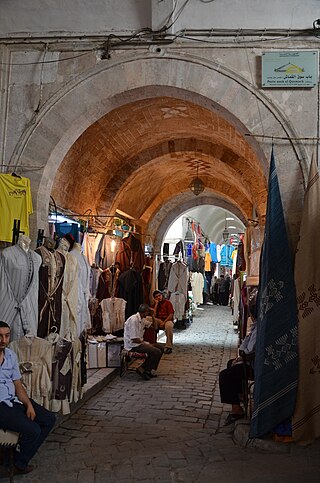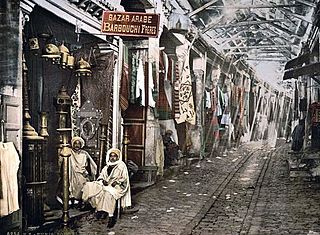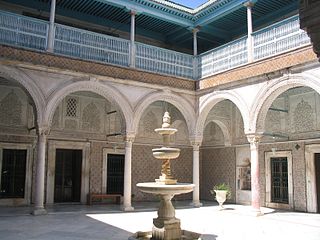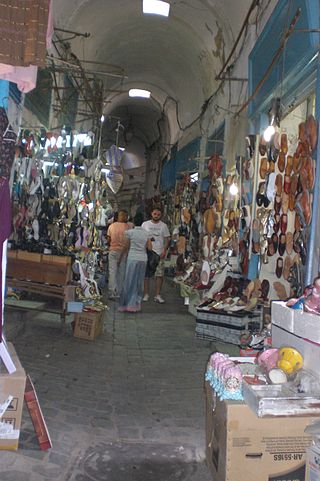
Souk El Berka is one of the souks of the medina of Tunis. The market traders specialize in the jewellery trade.

Souk El Berka is one of the souks of the medina of Tunis. The market traders specialize in the jewellery trade.
El Berka was built by Yusuf Dey in 1612 and was meant to sell slaves coming from West and Central Africa. Slaves of European origin, considered rarer and more precious, were not sold in the souk but in private locations because the sale concerned only wealthy potential buyers. This souk turned into a jewelers' souk after the abolition of slavery in Tunisia, decreed by Ahmad I ibn Mustafa in 1846.

The souk is located near the kasbah, the seat of the head of government, Dar El Bey and other souks, for example Souk El Bey, Souk Ech-Chaouachine, and Souk El Leffa. It is perpendicular to Souk El Trouk (Turks).
Located at the crossroads of four streets, Souk El Berka takes a square shape and has three aisles separated by two rows of columns. [1] Formerly a wooden platform at the centre was the place where slaves were presented (that was the origin of the name berka) and waited for the outcome of the sale. The place was covered by a central dome and several side vaults.

Tunis is the capital and largest city of Tunisia. The greater metropolitan area of Tunis, often referred to as "Grand Tunis", has about 2,700,000 inhabitants. As of 2020, it is the third-largest city in the Maghreb region and the eleventh-largest in the Arab world.

The Medina of Tunis is the medina quarter of Tunis, the capital of Tunisia. It has been a UNESCO World Heritage Site since 1979.

Sidi Mahrez Mosque, also known as Mohamed Bey El Mouradi Mosque, is a mosque in Tunis, Tunisia. It is an official historical monument.
Hammuda Pasha Bey, died April 13, 1666 was the second Bey of the Tunisian Muradid dynasty. He reigned from 1631 until his death.

Souk El Bey is one of the souks of the medina of Tunis.
Souk Ech-Chaouachine is one of the souks of the medina of Tunis. Divided into three parts, it is specialized in chachia trading.

Souk El Bchemkya is one of the souks of the medina of Tunis. It used to be specialised in selling bechmak.

The souks of Tunis are a set of shops and boutiques located in the medina of Tunis, capital of Tunisia. Most of the souks were built under the Hafsid dynasty in the 13th century and near the Al-Zaytuna Mosque.

Souk El Kmach or the fabrics market is one of the most important souks of the medina of Tunis. It is the place where fabrics and tissues are sold, whether they are made in Tunisia or luxury products especially imported like silk or linen.

Souq Al Bchamkiya is a former souk of the medina of Tunis, specialized in bechmak trading.

Souk El Kebabjia is one of the souks of the medina of Tunis. It is specialized in the trading of traditional clothing accessories. Its craftsmen are specialized in kbaïeb, plural kobba.

Souk El Trouk is one of the souks of the medina of Tunis. It is specialized in clothing and embroidery trading.

Dar Ben Abdallah is an old palace in the medina of Tunis.

Souk El Blaghgia is one of the souks of the medina of Tunis.

Souk El Jedid is one of the souks in the medina of Tunis.

Souk El Beransia is one of the souks of the medina of Tunis.

Souk El Dziria or Souk of the Algerians is one of the souks of the medina of Tunis.

Souk El Sagha is one of the souks in the medina of Tunis. It is specialized in the selling of gold products.

Souk Erbaa is one of the souks in the medina of Tunis.

The Hussein Bey Mosque is a mosque located in Constantine, Algeria.